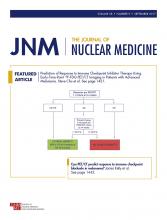TO THE EDITOR: An interesting paper in JNM (1) showed that an 18F-FDG PET application can, with care, attain nearly 10% SUV repeatability and that when this level of precision is attained, the use of a glucose correction can be worth considering. Notably, the researchers investigated whether a correction, G × SUV, can further improve results because of the influence of glucose concentration (c) on uptake. For that particular repeatability study—with the particular c range of its 11 patients and the particular correction algorithm it chose—the correction adversely affected the results. Nevertheless, on the basis of the information below, other PET studies seeking precision are encouraged to follow this example of investigating such a correction and to implement an appropriate algorithm when advantageous.
The historical tradition has always assumed that G = c/c0. Here, SUV is corrected to its value at a standard concentration c0. However, it has long been pointed out that the manner in which c influences SUV for 18F-FDG varies among tissues (2). Hence, a preferred approach is to determine a c dependence of G that is valid for a particular tissue (or average among the tissue types present). This determination involves ad hoc measurements of the sensitivity of SUV to c. One empiric formalism (3,4) defines this sensitivity as γ = [dSUV/SUV]/[dc/c], which is the slope of ln(SUV) versus ln(c) data. A consequence is that G = (c/c0)−γ. Alternatively, and having a physiologic basis, a Michaelis–Menten formalism may be somewhat reasonably assigned to SUVs, with G = (KM + c)/(KM + c0) (4,5). An empiric half-saturation constant KM would be obtained from parameterized sensitivity measurements. The two formalisms are related, with γ ≈ −1/(1+KM/c0) for cases of encountered c not far from c0. Values for γ have been found to be dependent on the tissue studied, with all being essentially in the range of 0 to −1 (3,4,6).
In the absence of such data, it may sometimes be possible to bracket results by simply trying γ-values, such as 0 and −1. However, caution in reaching conclusions from such trials must be exercised by being sure, first, that an adequate number of patients is used for the statistical significance desired in the presence of random factors, and second, that any patients with the larger |c – c0| are satisfactorily corrected.
Regarding larger departures from c0, a useful option has been suggested (7): implementation of G × SUV only if a patient’s |G – 1| exceeds some chosen lower bound. Here, investigation of the correction directs attention to accuracy in classifying patients with a larger |c – c0|. Additionally, it can be that the correcting process for others, whether or not implemented, may not significantly affect the ultimate results.
Any investigation for a particular 18F-FDG application would seek the proper γ and possibly decide on any |G – 1| lower-bound option. An inappropriate γ leads to over- or undercorrection, with the consequent added variability in results. In selecting an appropriate algorithm, one should attend to, first, a reduction in the variance of some result (e.g., a measured marker or a feature of the receiver-operating characteristic), and second, an improved ability to accommodate patients with a somewhat outlying c. Interestingly, regarding this latter point, a particular pancreas scan protocol reported a G of as high as 2.9 as being able to improve diagnostic results (6). Of interest to clinicians may be the flexibility of being able to accept a wider range of c than is typically recommended for high-quality scans.
Although the approach described here could theoretically be valid, it may not always have a statistically significant impact on the final goals of a protocol. This impact depends on the tissue type, the largest |c – c0| a clinician will accept, and the importance of other random factors beyond c variability, such as the variability from a particular institution's methods of acquiring data and the variability in the SUVs of the particular population. Thus, in perhaps many circumstances, although implementation of a glucose correction may theoretically be correct, the resulting refinement would be statistically undetectable.
In summary, for those performing 18F-FDG PET studies in which the final results might noticeably benefit from added PET procedural precision, I encourage investigation of glucose correction using an algorithm appropriate for their needs. Additionally, to support the corrections, it would be worthwhile to gather and report the SUV sensitivity data for common tissue types.
Footnotes
Published online Jan. 26, 2017.
- © 2017 by the Society of Nuclear Medicine and Molecular Imaging.







